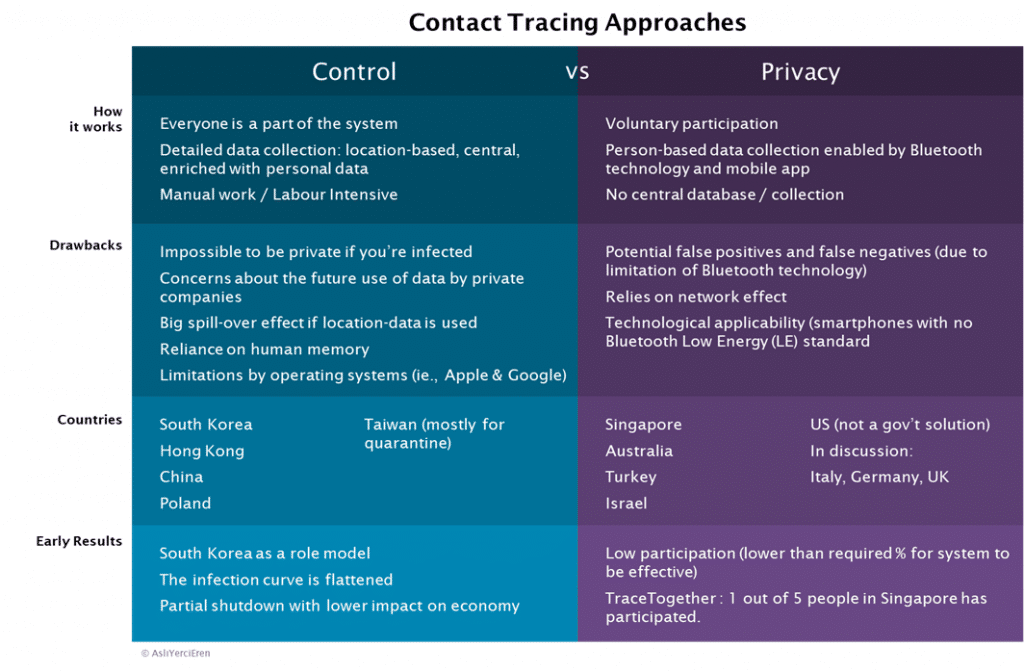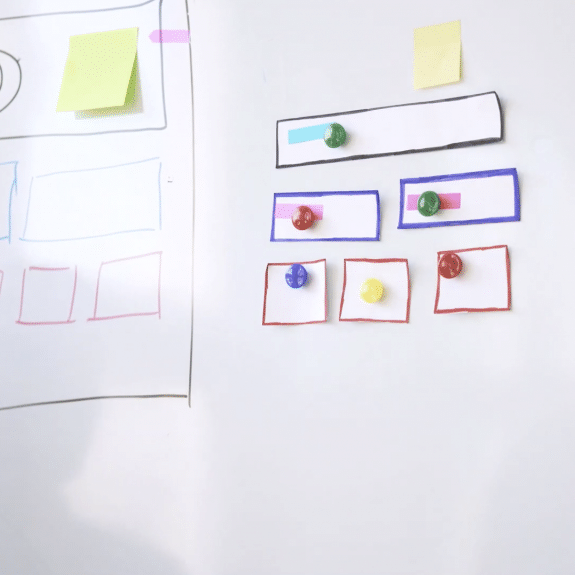Contact Tracing for COVID-19: Control vs. Privacy
Contact Tracing for COVID-19: Control vs. Privacy
Having millions of people in quarantine, many governments are under financial pressure to reopen the economy and lift the restrictions as soon as possible due to increasing economic impact. While some governments outline a multiphase plan to pull out of the country’s coronavirus shutdown, other countries are also experimenting with a gradual reopening. Italy, Spain, Germany, Switzerland and Austria have already allowed partial returns to work. While reopening is under discussion, countries are investigating new ways to trace the virus’ journey and keep coronavirus spread under control. Some countries imply more restrictive measures as many are developing their own apps for contact tracing. It seems that contact tracing apps will be a part of our “new normal” life which has been redefining with the crisis.
What is Contact Tracing? Why is it important?
Contact tracing helps limit the spread of virus by proactively identifying people at higher than others due to potential exposure, notifying them and quarantining them if necessary. When someone is diagnosed with a virus, contact tracers can use different methods to figure out who they have recently been in contact with.
Approaches for Contract Tracing
Contact tracing can be done using different methods, but if we look at the approaches taken by the governments today we can say that there are two main approaches that can be observed with slight differences in implementation.
First approach heavily relies on manual tracing and investigating the diagnosed person’s recent activities and contact using various personal data sources such as credit card information, location data, bank transactions which might not be reached by others under other circumstances. The use of GPS data and interviews with the person is widely used to trace contact and keep the person at high risk under quarantine.
The second approach is a mobile-based solution enabled by bluetooth technology, and it mainly differentiates from the first approach by being a voluntary system and keeping data more private.

As the first approach has been implied by countries such as South Korea, Hong Kong being a model for keeping the spread under control, any discussion around a central data collection raises a lot of concerns about privacy in France, Germany and the U.S. Many believe that a system with centralized data collection and control cannot be accepted by the public in Europe and the U.S.
While the full control system is triggering many push backs from the public, the bluetooth-based contact tracing solution is far from perfect. Since the system heavily relies on network effect, being used by the majority of the population is the most critical factor for the solution to be successful.
In addition to self-developed technologies of governments, Apple and Google partnered on COVID-19 contact tracing technology that omits using GPS to track people’s location due to privacy concerns. The software released in mid-May is meant to be integrated with government apps. Though many European countries have announced they’ll use tech from Apple and Google, countries like France, the UK, and several US states favor government-run contact tracing apps.
Apps that adopt Apple and Google’s API can customise it within certain limits. But they are not be able to log, for example, a phone’s GPS coordinates. Here, you can find more on how governments are responding to COVID-19 with their contact tracing apps.
The Solution
As contact tracing apps and systems help us to identify the virus’ journey, all systems which have been implemented by governments today have some pitfalls in the implementation and cannot be the sole solution to defend ourselves against the pandemic. Whether it is a solution implemented with extensive data collection or one with voluntary participation, its effectiveness is determined by the people following self-isolation rules once they are identified as a high-risk person who are potentially infected. The more we imply precautionary actions with great care, the shorter time it is required to contain the pandemic.
Reading Time: 5 minutes
Don’t miss out the latestCommencis Thoughts and News.

Commencis
Don’t miss out the latestCommencis Thoughts and News.
04/05/2020
Reading Time: 5 minutes
Having millions of people in quarantine, many governments are under financial pressure to reopen the economy and lift the restrictions as soon as possible due to increasing economic impact. While some governments outline a multiphase plan to pull out of the country’s coronavirus shutdown, other countries are also experimenting with a gradual reopening. Italy, Spain, Germany, Switzerland and Austria have already allowed partial returns to work. While reopening is under discussion, countries are investigating new ways to trace the virus’ journey and keep coronavirus spread under control. Some countries imply more restrictive measures as many are developing their own apps for contact tracing. It seems that contact tracing apps will be a part of our “new normal” life which has been redefining with the crisis.
What is Contact Tracing? Why is it important?
Contact tracing helps limit the spread of virus by proactively identifying people at higher than others due to potential exposure, notifying them and quarantining them if necessary. When someone is diagnosed with a virus, contact tracers can use different methods to figure out who they have recently been in contact with.
Approaches for Contract Tracing
Contact tracing can be done using different methods, but if we look at the approaches taken by the governments today we can say that there are two main approaches that can be observed with slight differences in implementation.
First approach heavily relies on manual tracing and investigating the diagnosed person’s recent activities and contact using various personal data sources such as credit card information, location data, bank transactions which might not be reached by others under other circumstances. The use of GPS data and interviews with the person is widely used to trace contact and keep the person at high risk under quarantine.
The second approach is a mobile-based solution enabled by bluetooth technology, and it mainly differentiates from the first approach by being a voluntary system and keeping data more private.

As the first approach has been implied by countries such as South Korea, Hong Kong being a model for keeping the spread under control, any discussion around a central data collection raises a lot of concerns about privacy in France, Germany and the U.S. Many believe that a system with centralized data collection and control cannot be accepted by the public in Europe and the U.S.
While the full control system is triggering many push backs from the public, the bluetooth-based contact tracing solution is far from perfect. Since the system heavily relies on network effect, being used by the majority of the population is the most critical factor for the solution to be successful.
In addition to self-developed technologies of governments, Apple and Google partnered on COVID-19 contact tracing technology that omits using GPS to track people’s location due to privacy concerns. The software released in mid-May is meant to be integrated with government apps. Though many European countries have announced they’ll use tech from Apple and Google, countries like France, the UK, and several US states favor government-run contact tracing apps.
Apps that adopt Apple and Google’s API can customise it within certain limits. But they are not be able to log, for example, a phone’s GPS coordinates. Here, you can find more on how governments are responding to COVID-19 with their contact tracing apps.
The Solution
As contact tracing apps and systems help us to identify the virus’ journey, all systems which have been implemented by governments today have some pitfalls in the implementation and cannot be the sole solution to defend ourselves against the pandemic. Whether it is a solution implemented with extensive data collection or one with voluntary participation, its effectiveness is determined by the people following self-isolation rules once they are identified as a high-risk person who are potentially infected. The more we imply precautionary actions with great care, the shorter time it is required to contain the pandemic.




